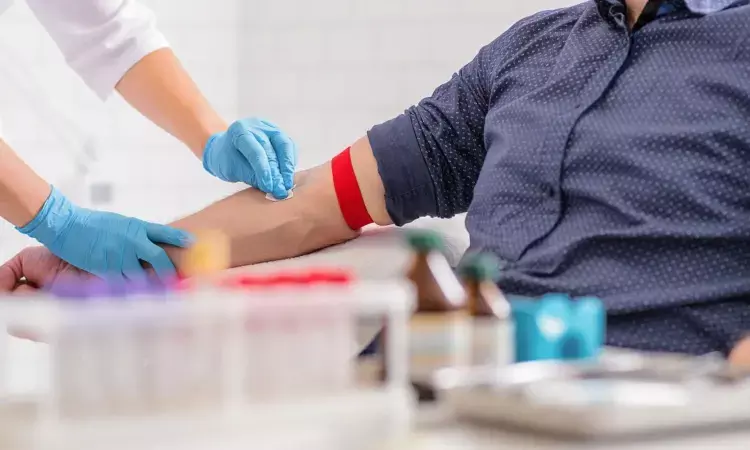- Home
- Medical news & Guidelines
- Anesthesiology
- Cardiology and CTVS
- Critical Care
- Dentistry
- Dermatology
- Diabetes and Endocrinology
- ENT
- Gastroenterology
- Medicine
- Nephrology
- Neurology
- Obstretics-Gynaecology
- Oncology
- Ophthalmology
- Orthopaedics
- Pediatrics-Neonatology
- Psychiatry
- Pulmonology
- Radiology
- Surgery
- Urology
- Laboratory Medicine
- Diet
- Nursing
- Paramedical
- Physiotherapy
- Health news
- Fact Check
- Bone Health Fact Check
- Brain Health Fact Check
- Cancer Related Fact Check
- Child Care Fact Check
- Dental and oral health fact check
- Diabetes and metabolic health fact check
- Diet and Nutrition Fact Check
- Eye and ENT Care Fact Check
- Fitness fact check
- Gut health fact check
- Heart health fact check
- Kidney health fact check
- Medical education fact check
- Men's health fact check
- Respiratory fact check
- Skin and hair care fact check
- Vaccine and Immunization fact check
- Women's health fact check
- AYUSH
- State News
- Andaman and Nicobar Islands
- Andhra Pradesh
- Arunachal Pradesh
- Assam
- Bihar
- Chandigarh
- Chattisgarh
- Dadra and Nagar Haveli
- Daman and Diu
- Delhi
- Goa
- Gujarat
- Haryana
- Himachal Pradesh
- Jammu & Kashmir
- Jharkhand
- Karnataka
- Kerala
- Ladakh
- Lakshadweep
- Madhya Pradesh
- Maharashtra
- Manipur
- Meghalaya
- Mizoram
- Nagaland
- Odisha
- Puducherry
- Punjab
- Rajasthan
- Sikkim
- Tamil Nadu
- Telangana
- Tripura
- Uttar Pradesh
- Uttrakhand
- West Bengal
- Medical Education
- Industry
Non-Invasive and Cost-Effective: PLR Shows High Accuracy in Identifying Liver Fibrosis in HCV, Study Finds

Pakistan: Recent research published in the Cureus Journal has identified the platelet-to-lymphocyte ratio (PLR) as a reliable, non-invasive marker for detecting advanced liver fibrosis in patients with the Hepatitis C virus (HCV). The study revealed that a PLR cutoff of ≤5.41 achieved 85.71% sensitivity, 86.27% specificity, and 85.98% diagnostic accuracy, surpassing traditional markers like aminotransferase-to-platelet ratio index (APRI; 37% accuracy) and fibrosis-4 index (FIB-4; 40% accuracy).
The researchers emphasized that PLR offers a cost-effective and highly sensitive alternative to liver biopsy, making it particularly useful in low-resource healthcare settings. They noted that PLR’s affordability and diagnostic precision make it an invaluable tool for early fibrosis detection in HCV-infected individuals.
Hepatitis C virus infection remains a global health challenge, often leading to progressive liver fibrosis, cirrhosis, and hepatocellular carcinoma. Early detection of advanced liver fibrosis is crucial for initiating timely treatment and ensuring proper management. The researchers note that while liver biopsy is considered the gold standard for fibrosis staging, its invasive nature, high cost, and associated risks make it less ideal for routine use. As a result, non-invasive biomarkers like the platelet-to-lymphocyte ratio are gaining attention as alternative tools for fibrosis staging.
Against the above background, Vijesh Kumar, Hepatogastroenterology, Sindh Institute of Urology and Transplantation, Karachi, PAK, and colleagues aimed to evaluate the effectiveness of PLR in predicting advanced liver fibrosis in HCV-infected individuals.
For this purpose, the researchers conducted a retrospective study at the Sindh Institute of Urology and Transplantation (SIUT), Pakistan, involving patients aged 18+ with chronic HCV infection who underwent liver biopsy and shear wave elastography (SWE) between January 2018 and December 2023. Patients with other liver or hematological disorders and incomplete records were excluded. The study compared laboratory parameters, demographic data, and fibrosis scores, calculating the platelet-to-lymphocyte ratio (PLR). Diagnostic accuracy for PLR was assessed using AUROC curve analysis and compared to markers like APRI and FIB-4.
Key Findings:
• The study enrolled 107 HCV-infected patients with a mean age of 49.1 ± 8.9 years.
• Liver biopsy confirmed significant fibrosis (METAVIR score ≥ 2) in 56 (52.3%) patients.
• PLR was significantly lower in patients with advanced fibrosis (4.17 ± 1.44 vs. 6.8 ± 1.99).
• The AUROC for PLR was 0.879, indicating strong diagnostic ability.
• At an optimal cutoff of ≤5.41, PLR demonstrated:
• 85.71% sensitivity
• 86.27% specificity
• 85.98% diagnostic accuracy
• PLR outperformed APRI (37%) and FIB-4 (40%) in predicting advanced liver fibrosis in HCV patients.
This study emphasizes the value of the platelet-to-lymphocyte ratio as a simple, cost-effective, and highly sensitive non-invasive marker for advanced liver fibrosis in chronic HCV infection. PLR outperformed traditional markers like APRI and FIB-4 in diagnostic accuracy, sensitivity, and specificity.
"Since PLR is derived from routine CBC tests, it provides a reliable alternative to liver biopsy, particularly in resource-limited settings. The ease of implementing PLR in clinical practice makes it a valuable tool for early fibrosis detection and risk assessment," the authors noted. They further added, "However, further validation in larger studies is needed, and future research could explore combining PLR with other biomarkers and imaging techniques for enhanced accuracy."
Reference:
Kumar V, Aslam M, Kalwar S, et al. (April 24, 2025) Utility of the Platelet-to-Lymphocyte Ratio in Predicting Advanced Liver Fibrosis in the Hepatitis C Virus (HCV)-Infected Population. Cureus 17(4): e82882. doi:10.7759/cureus.82882
Dr Kamal Kant Kohli-MBBS, DTCD- a chest specialist with more than 30 years of practice and a flair for writing clinical articles, Dr Kamal Kant Kohli joined Medical Dialogues as a Chief Editor of Medical News. Besides writing articles, as an editor, he proofreads and verifies all the medical content published on Medical Dialogues including those coming from journals, studies,medical conferences,guidelines etc. Email: drkohli@medicaldialogues.in. Contact no. 011-43720751


